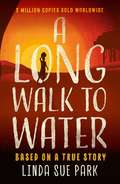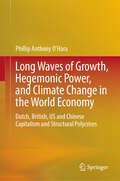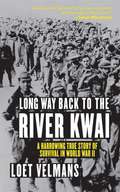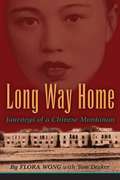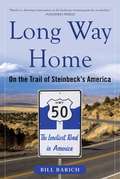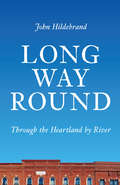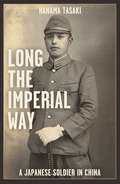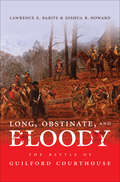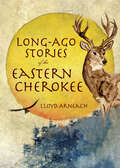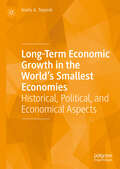- Table View
- List View
Long Walk to Water: Based on a True Story
by Linda Sue ParkA gripping tale of conflict and survival that has inspired millions of young readers and adults alike, with two million copies sold worldwide Eleven-year-old Salva is forced to flee on foot when his village comes under attack. Braving every imaginable hardship – including killer lions and hungry crocodiles – he is one of the 'lost boys' travelling the African continent on foot in search of his family and a safe place to stay. Nya goes to the pond two times a day to fetch water. It takes her eight hours. But there is unexpected hope, as these two stories set in Sudan – one unfolding in 2008 and one in 1985 – go on to intersect with Nya&’s in an astonishing and moving way.
Long Walk: M/TV
by Slavomir RawiczMORE THAN HALF A MILLION COPIES SOLD! The classic adventure story that inspired the new major motion picture The Way Back, directed by Peter Weir *** &“I hope The Long Walk will remain as a memorial to all those who live and die for freedom, and for all those who for many reasons could not speak for themselves.&”—Slavomir Rawicz"The Long Walk is a book that I absolutely could not put down and one that I will never forget..."--Stephen Ambrose "A poet with steel in his soul."--New York Times"One of the most amazing, heroic stories of this or any other time."--Chicago Tribune&“A book filled with the spirit of human dignity and the courage of men seeking freedom.&”—Los Angeles Times&“Heroism is not the domain of the powerful; it is the domain of people whose only other alternative is to give up and die…. [The Long Walk] must be read—and reread, and passed along to friends.&”—National Geographic Adventure&“The ultimate human endurance story…told with clarity, vivid description, and a good dash of romance and humor.&”—The Vancouver Sun"Essentially it comes down to some sort of inner tenacity and that is what is so gripping about the book because you know that this is actually about all of us. It's not just some Polish bloke who wanted to get home. It's about how we all struggle on every day. Somehow or other we find a reason to keep on going and it's the same here but on an epic scale".--Benedict Allen, explorer and bestselling author of Into the Abyss and Edge of Blue Heaven *** In 1941, the author and six fellow prisoners of war escaped a Soviet labor camp in Yakutsk—a camp where enduring hunger, cold, untended wounds, and untreated illnesses, and avoiding daily executions were everyday feats. Their march—over thousands of miles by foot—out of Siberia, through China, the Gobi Desert, Tibet, and over the Himalayas to British India is a remarkable statement about man&’s desire to be free. Written in a hauntingly detailed, no-holds-barred way, the book inspired the Peter Wier film The Way Back, due for release in late 2010. Previous editions have sold hundreds of thousands of copies; this edition includes an afterword written by the author shortly before his death, as well as the author's introduction to the book's Polish edition. Guaranteed to forever stay in the reader's mind, The Long Walk will remain a testament to the strength of the human spirit, and the universal desire for freedom and dignity. *** Six-time Academy Award–nominee Peter Weir (Master and Commander, The Truman Show, and The Dead Poets Society) recently directed The Way Back, a much-anticipated film based on The Long Walk. Starring Colin Farrell, Jim Sturgess, and Ed Harris, it is due for release in late 2010.
Long Wars and the Constitution
by Stephen M. GriffinIn a wide-ranging constitutional history of presidential war decisions from 1945 to the present, Stephen M. Griffin rethinks the long-running debate over the imperial presidency and concludes that the eighteenth-century Constitution is inadequate to the challenges of a post-9/11 world. The Constitution requires the consent of Congress before the United States can go to war. Truman’s decision to fight in Korea without gaining that consent was unconstitutional, says Griffin, but the acquiescence of Congress and the American people created a precedent for presidents to claim autonomy in this arena ever since. The unthinking extension of presidential leadership in foreign affairs to a point where presidents unilaterally decide when to go to war, Griffin argues, has destabilized our constitutional order and deranged our foreign policy. Long Wars and the Constitution demonstrates the unexpected connections between presidential war power and the constitutional crises that have plagued American politics. Contemporary presidents are caught in a dilemma. On the one hand are the responsibilities handed over to them by a dangerous world, and on the other is an incapacity for sound decisionmaking in the absence of interbranch deliberation. President Obama’s continuation of many Bush administration policies in the long war against terrorism is only the latest in a chain of difficulties resulting from the imbalances introduced by the post-1945 constitutional order. Griffin argues for beginning a cycle of accountability in which Congress would play a meaningful role in decisions for war, while recognizing the realities of twenty-first century diplomacy.
Long Waves of Growth, Hegemonic Power, and Climate Change in the World Economy: Dutch, British, US and Chinese Capitalism and Structural Polycrises
by Phillip Anthony O'HaraThis book investigates eras of major geopolitical and socioeconomic power, development, relative demise and potential renewal, for four major political economies. It concentrates on the Dutch Golden Age of the late 1500s and 1600s, British hegemony of the 1800s, Pax Americana of the 1900s, and Chinese potential hegemony of the 2000s, as well as long wave patterns of change over successive centuries to the present (and to some degree into the future). Dutch, British, US and Chinese economies are situated within patterns of long-term successive rise and fall (and fall and rise) of economic growth, hegemony and climate change in the world political economy, including linkages between core, periphery and semi-periphery. Patterns of multiple crises tend to appear in-between hegemonic periods, and climate change often undergoes complex dynamics through time, while currently climate anomalies are emerging during mostly long wave downswings and polycrises in the world economy. Contemporary themes of the book include the ongoing competition for world domination between the US and China, the conflict over Ukraine-Taiwan that some think may generate world-war 3, the climate change crisis that continues to plague the world, and whether the world and its major economies are likely to undergo a Golden Age into the future. Chapter 7 of this book on US hegemony and long waves includes extracts of material that won the Myrdal Prize for Book of the Year Prize from EAEPE as well as Journal Article of the Year from Curtin Business School. Ideas from parts of Chapter 9 emanate from a volume that won Book of the Year Award from CBS. A climate change paper that won Journal Article of the Year Awards from EAEPE and CBS informed ideas that are used in several parts of this book. The book outlines key stylized facts from the analysis and presents hypotheses for further investigation on the relationship between long-term growth, hegemony and climate change. The book uses the work of Kondratiev, Schumpeter, and company, themes in economic history, modern political economy schools, and the principles of political economy contingency paradigm to reformulate long wave, hegemony and climate change hypotheses and empirics.
Long Way Back to the River Kwai: Memories of World War II
by Loet VelmansLoet Velmans was seventeen when the Germans invaded Holland. He and his family fled to London on the Dutch Coast Guard cutter Seaman's Hope and then sailed to the Dutch East Indies-now Indonesia-where he joined the Dutch army. In March 1942, the Japanese invaded the archipelago and made prisoners of the Dutch soldiers. For the next three and a half years Velmans and his fellow POWs toiled in slave labor camps, building a railroad through the dense jungle on the Burmese-Thailand border so the Japanese could invade India. Some 200,000 POWs and slave laborers died building this Death Railway. Velmans, though suffering from malaria, dysentery, malnutrition, and unspeakable mistreatment, never gave up hope. Fifty-seven years later he returned to revisit the place where he should have died and where he had buried his closest friend. From that emotional visit sprung this stunning memoir.Long Way Back to the River Kwai is a simply told but searing memoir of World War II-a testimonial to one man's indomitable will to live that will take its place beside the Diary of Ann Frank, Bridge over the River Kwai, and Edith's Story.
Long Way Home: Journeys of a Chinese Montanan
by Flora WongIn 1936, seven-year-old Flora Wong, her parents, and her seven siblings left their home in Boston and set out across the Pacific Ocean on a twenty-one-day voyage to return to her parents' home village in rural southern China. Flora's father and mother sought a new, quiet life for their young family in their native land.
Long Way Home: On the Trail of Steinbeck's America
by Bill Bairch“We do not take a trip; a trip takes us,” John Steinbeck noted in his 1962 classic, Travels with Charley. In 2008, Bill Barich decided to explore the mood of the United States as Steinbeck had done almost a half century before. He set off on a 5,943 mile cross-country drive from New York to his old hometown of San Francisco on Route 50, a road twisting through the American heartland. Long Way Home is the stunning result of his pilgrimage. From the Eastern Shore of Maryland to the spectacular landscape of Moab, Utah, to Steinbeck’s own Salinas Valley, the book is filled with memorable encounters and rich in history and local color; a truthful, inspired account of a once-in-a-lifetime trip. It offers an incisive portrait of a nation divided and the grassroots dissatisfaction that ultimately catapulted Donald Trump into the White House. From the Eastern Shore of Maryland to the spectacular landscape of Moab, Utah, to Steinbeck's own Salinas Valley, filled with memorable encounters and redolent with history and local color, Long Way Home is a truthful, inspiring account of the country at a social and political crossroad.
Long Way Round: Through the Heartland by River
by John HildebrandLong Way Round: Through the Heartland by River
Long Way Round: Through the Heartland by River
by John HildebrandInspired by tales of a mythic Round River, a circular stream where "what goes around comes around," John Hildebrand sets off to rediscover his home state. Wisconsin is in the midst of an identity crisis, torn by new political divisions and the old gulf between city and countryside. Cobbling rivers together, from the burly Mississippi to the slender wilds of Tyler Forks, Hildebrand navigates the beautiful but complicated territory of home. In once prosperous small towns, he discovers unsung heroes—lockmasters, river rats, hotelkeepers, mechanics, environmentalists, tribal leaders, and perennial mayors—struggling to keep their communities afloat. While history doesn't flow in a circle, it doesn't always move in a straight line either. Hildebrand charts the improbable ox-bows along its course. Long Way Round shows us the open road as a river with possibility around the next bend.
Long the Imperial Way
by Hanama TasakiLong the Imperial Way, first published in the U.S. in 1950, is a realistic portrayal of life in the Japanese Imperial Army during the late 1930’s. The book is based on the author’s own experiences during the three years he served as a private in China (author Tasaki, raised in Hawaii, wrote the book in English). The book details the rites ingrained in the soldiers, demanding sacrifice and unquestioning obedience to superior officers. Scenes include the burning of Chinese villages, harsh beatings of the First Year Soldiers by those with more seniority, and unrestrained pillaging. Long the Imperial Way remains one of the few books which provide insight into the experiences of the typical Japanese soldier in the period just prior to World War Two.
Long, Obstinate, and Bloody
by Joshua B. Howard Lawrence E. BabitsOn March 15, 1781, the armies of Nathanael Greene and Lord Charles Cornwallis fought one of the bloodiest and most intense engagements of the American Revolution at Guilford Courthouse in piedmont North Carolina. In Long, Obstinate, and Bloody, the first book-length examination of the Guilford Courthouse engagement, Lawrence E. Babits and Joshua B. Howard piece together what really happened on the wooded plateau in what is today Greensboro, North Carolina, and identify where individuals stood on the battlefield, when they were there, and what they could have seen, thus producing a new bottom-up story of the engagement.
Long-Ago Stories of the Eastern Cherokee (American Heritage)
by Lloyd ArneachTragically, relatively little of this flourishing nation and its rich culture has survived. Its stories, however, live on today. In this priceless and engaging collection, native Cherokee and professional storyteller Lloyd Arneach recounts tales such as how the bear lost his long bushy tail and how the first strawberry came to be.
Long-Term Economic Growth in the World's Smallest Economies: Historical, Political, and Economical Aspects
by Aneta A. TeperekThis book investigates the historical, political, and economic circumstances of the world's smallest economies as key determinants influencing their economic growth and development. A historical survey of the global economy provides an introduction to the history of the world's smallest economies, which are examined based on their shared historical characteristics (colonialism, socialism and independence). In addition to historical factors, the reasons are sought in the political systems, especially the political regimes of the countries under study, as well as in the intensity of their integration with the global economy through membership in international organisations. The majority of the book is dedicated to economic aspects, which have been studied for nearly fifty years. This includes an investigation into the factors influencing GDP and GDP per capita fluctuations across all countries. To assess levels of socio-economic development and quality of life, the Human Development Index was employed as a means of assessment. This book is addressed to students and scholars engaged in research or with an interest in economic history, political systems, international relations, and the growth and economic development of the world’s 93 smallest economies, generating 1% of global GDP.
Long-Term Health Consequences of Exposure to Burn Pits in Iraq and Afghanistan
by Committee on the Long-Term Health Consequences of Exposure to Burn Pits in Iraq AfghanistanMany veterans returning from the conflicts in Iraq and Afghanistan have health problems they believe are related to their exposure to the smoke from the burning of waste in open-air "burn pits" on military bases. Particular controversy surrounds the burn pit used to dispose of solid waste at Joint Base Balad in Iraq, which burned up to 200 tons of waste per day in 2007. The Department of Veterans Affairs asked the IOM to form a committee to determine the long-term health effects from exposure to these burn pits. Insufficient evidence prevented the IOM committee from developing firm conclusions. This report, therefore, recommends that, along with more efficient data-gathering methods, a study be conducted that would evaluate the health status of service members from their time of deployment over many years to determine their incidence of chronic diseases.
Long-Vowel Shifts in English, c. 1050–1700
by Gjertrud Flermoen StenbrendenThe English language has undergone many sound changes in its long history. Some of these changes had a profound effect on the pronunciation of the language. A number of these significant instances of language evolution are generally grouped together and termed the 'Great Vowel Shift'. These changes are generally considered to be unrelated to other, similar long-vowel changes taking place a little earlier. This book assesses an extensive range of irregular Middle English spellings for all these changes, with a view to identifying the real course of events: the dates, the chronology, and the dialects that stand out as being innovative. Using empirical evidence to offer a fresh perspective and drawing new, convincing conclusions, Stenbrenden offers an interpretation of the history of the English language which may change our view of sound change completely.
Longbourn
by Jo Baker* Pride and Prejudice was only half the story * If Elizabeth Bennet had the washing of her own petticoats, Sarah often thought, she'd most likely be a sight more careful with them. In this irresistibly imagined belowstairs answer to Pride and Prejudice, the servants take center stage. Sarah, the orphaned housemaid, spends her days scrubbing the laundry, polishing the floors, and emptying the chamber pots for the Bennet household. But there is just as much romance, heartbreak, and intrigue downstairs at Longbourn as there is upstairs. When a mysterious new footman arrives, the orderly realm of the servants' hall threatens to be completely, perhaps irrevocably, upended. Jo Baker dares to take us beyond the drawing rooms of Jane Austen's classic--into the often overlooked domain of the stern housekeeper and the starry-eyed kitchen maid, into the gritty daily particulars faced by the lower classes in Regency England during the Napoleonic Wars--and, in doing so, creates a vivid, fascinating, fully realized world that is wholly her own. This ebook edition includes a Reading Group Guide.
Longbow Girl
by Linda DaviesThe stunningly written start to an exciting new trilogy about a smart, strong, bold girl who travels back in time to protect her family's past and ensure its future using her archery skills.Set in the wilds of the Welsh mountains, the brave and beautiful longbow girl, Merry Owen, discovers a river that takes her back in time to the autocratic kingdom of King Henry VIII. While there she finds she must compete in an archery tournament to save her ancestors' land from being seized by their aristocratic neighbors the de Courcys. Merry's best friend James de Courcy (and heir to the de Courcy wealth) follows her back in time and the two get tangled up in their families' ancient histories. There are forces working against them both in the past and the present. Will they be able to survive their pasts to save their futures?
Longfellow: A Rediscovered Life
by Charles C. CalhounCharles C. Calhoun's Longfellow gives life, at last, to the most popular American poet who ever lived, a nineteenth-century cultural institution of extraordinary influence and the"one poet average, nonbookish Americans still know by heart" (Dana Gioia).Calhoun's Longfellow emerges as one of America's first powerful cultural makers: a poet and teacher who helped define Victorian culture; a major conduit for European culture coming into America; a catalyst for the Colonial Revival movement in architecture and interior design; and a critic of both Puritanism and the American obsession with material success. Longfellow is also a portrait of a man in advance of his time in championing multiculturalism: He popularized Native American folklore; revived the Evangeline story (the foundational myth of modern Acadian and Cajun identity in the U.S. and Canada); wrote powerful poems against slavery; and introduced Americans to the languages and literatures of other lands.Calhoun's portrait of post-Revolutionary Portland, Maine, where Longfellow was born, and of his time at Bowdoin and Harvard Colleges, show a deep and imaginative grasp of New England cultural history. Longfellow's tragic romantic life-his first wife dies tragically early, after a miscarriage, and his second wife, Fannie Appleton, dies after accidentally setting herself on fire-is illuminated, and his intense friendship with abolitionist and U.S. senator Charles Sumner is given as a striking example of mid-nineteenth-century romantic friendship between men. Finally, Calhoun paints in vivid detail Longfellow's family life at Craigie House, including stories of the poet's friends-Hawthorne, Emerson, Dickens, Fanny Kemble, Julia Ward Howe, and Oscar Wilde among them.
Longhorns East
by Johnny D. BoggsFrom nine-time Spur Award–winning Western author Johnny D. Boggs comes the incredible story of the biggest, longest, wildest cattle drive in America&’s history—from the heart of Texas to New York City. . . . LONGHORNS EAST Tom Candy Ponting was no ordinary trail boss. He didn&’t smoke, chew, cuss, or even carry a gun. Unlike his competitors, he learned how to herd cows on a farm back in England—and how to handle cowboys in bareknuckle prizefights. But his skills and know-how were really put to the test when he accepts a bet he might live to regret: lead a cattle drive from Texas to New York City. Not one to back down on a dare, Ponting assembles the motliest crew of cowboys ever seen—Texans, Englishmen, Mexicans, Freemen, Cherokee—and charts a course through the unfriendliest country to move seven hundred head of cattle, never easy in the best of times. Along the way, they&’ll cross railroads and rustlers, hucksters and hustlers, with detours and dead ends aplenty. But if they succeed, the team will make more than just a whole lot of money. They will make history. . . . Inspired by the real-life adventures of legendary cattleman Tom Candy Ponting, Longhorns East takes readers on an unforgettable journey as big and bold as the America itself. &“Boggs is unparalleled in evoking the gritty reality of the Old West.&” —The Shootist &“Johnny Boggs has produced another instant page-turner. . . . Don&’t put down the book until you finish it.&” —Tony Hillerman on Killstraight&“Johnny D. Boggs tells a crisply powerful story that rings true more than two centuries after the bloody business was done.&” —The Charleston (S.C.) Post and Courier on The Despoilers
Longing
by J. D. LandisLonging tells the story of the greatest artistic couple in history, Robert Schumann and Clara Wieck. They met when she was eight years old and he was seventeen, drawn together first by music and then by their passion for each other. Drawing on their letters and remarkably frank journals, J. D. Landis writes of Clara and Robert's enforced separations, their marriage, their artistic triumphs and failures, and finally their shared devotion to, and love for, a young genius who both came between them and brought them together for the last time. Longing was a New York Times Notable Book. It was also named by The Guardian (London) as the second finest novel about music (the first being Thomas Bernhard's Loser, a judgment with which Mr. Landis is delighted to concur).
Longing
by Mary BaloghFrom New York Times bestselling legend and author of the Survivors' Club series comes a cherished novel about the risks and the compromises that come with falling in love.... Governess and mistress--he wanted her as both....The illegitimate daughter of an English lord, Sian Jones abandoned her heritage to live in a stalwart coal mining community in South Wales. Empowered by their cause, she's engaged to be married to the leader of a revolutionary movement that is bracing itself against the tyranny of English mine owners. But Sian's principles are unexpectedly shaken when she accepts a job as governess under Alexander Hyatt, the mysterious Marquess of Craille, the oppressive symbol of everything she has come to resist. She never expected Alexander to upend all her expectations. He is sympathetic to her cause. He is a loving father. A man of wealth and position, he is fatally attractive. And he is offering his heart to the independent woman who has illuminated his life. Now, caught between two worlds, and between the promises and desires of two men, Sian must make a choice that will define her future--one that can only be made in the name of love....
Longing and Belonging: Jews in the Modern Islamic World (Jewish Culture and Contexts)
by Nancy E. Berg and Dina DanonThis volume explores the history of Jewish life and experience in the modern Islamic worldLonging and Belonging investigates the lives of Jews among Muslims in the modern age, both inside and outside the Ottoman Empire and after its demise. Here, modern Jewish protagonists are revealed as active participants in an expansive Islamic civilization, reflecting a mutuality and cross-fertilization in the region that raises new lines of inquiry and which offers enduring lessons for the world today. This collection both foregrounds the experiences of Jewish communities that have long been relegated to the margins of historical and literary studies and, critically, uses these experiences to complicate prevailing narratives from both Jewish and Middle Eastern Studies. By following communities from the coffeeshops of Cairo to the villages of Yemen, from the local marriage market in Izmir to the global commerce of the Sassoons, readers gain intimate insight into a world that resists a simple understanding of the modern Islamic world and of the place of Jews within it. Just as much as the Sephardi and Mizrahi experience complicates prevailing paradigms in the study of Jewish modernity, so too does it enrich understandings of modernity across Muslim societies. The volume tells a story of longing, belonging, and longing to belong, of multiple affinities in a world that no longer exists.Contributors: Esra Almas, Nancy E. Berg, Dina Danon, Keren Dotan, Annie Greene, Alma Rachel Heckman, Hadar Feldman Samet, Joseph Sassoon, Edwin Seroussi, Alon Tam, Alan Verskin, Mark Wagner.
Longing for Her Forbidden Viking (To Wed a Viking #2)
by Harper St. George“A deeply sensual, evocative, mesmerizing and fabulously intriguing story . . . I hand on heart cannot recommend this book and this series enough.” —Chicks, Rogues and ScandalsSaxon maiden Ellan would rather wed a Dane than be forced into marriage by her father. In fact, she has one Dane in mind. But strong warrior Aevir has been ordered to marry for duty—all he can offer Ellan is a place as his concubine!She may be bold, but Ellan can never accept that. Even if his burning kisses make it incredibly tempting . . .“Harper St. George is a must-buy for me!” —Terri Brisbin, USA Today–bestselling author
Longing for a Cowboy Christmas
by Leigh Greenwood Rosanne Bittner Anna Schmidt Margaret Brownley Linda Broday Amy SandasFind your very own cowboy to keep warm these long, wintry nights as you cozy up with six sweeping, epic tales of heroism, passion, family and celebration from bestselling authors Leigh Greenwood, Rosanne Bittner, Linda Broday, Margaret Brownley, Anna Schmidt, and Amy Sandas.Fall in Love with ChristmasWhether it's a widower finding an unexpected new start, a former outlaw and his new wife welcoming their very own Christmas miracle, a long-lost lover returning just in time for a special holiday celebration, a second chance at love between two warring hearts given peace at last, an unlikely pair working together to bring joy to a small Texas town, or a cowboy and his dark-eyed beauty snowed in one unforgettable wintry eve...every Christmas with a cowboy is filled with light, laughter, and a forever kind of love.What People Are Saying:"Greenwood is a master at westerns." —RT Book Reviews for Leigh Greenwood"An emotional powerhouse! This classic historical western is destined for the "keeper" shelf." —RT Book Reviews, Top Pick for Rosanne Bittner"Fun and sensual...great for fans of history, romance, and some good old Texas grit."—Kirkus for Linda Broday"A great story by a wonderful author."—#1 New York Times bestselling author DEBBIE MACOMBER for Margaret Brownley"The perfect read." —RT Book Reviews for Anna Schmidt"A genuine page-turner...electric and absorbing." —Kirkus for Amy Sandas
Longing for the Bomb
by Lindsey A. FreemanLonging for the Bomb traces the unusual story of the first atomic city and the emergence of American nuclear culture. Tucked into the folds of Appalachia and kept off all commercial maps, Oak Ridge, Tennessee, was created for the Manhattan Project by the U.S. government in the 1940s. Its workers labored at a breakneck pace, most aware only that their jobs were helping "the war effort." The city has experienced the entire lifespan of the Atomic Age, from the fevered wartime enrichment of the uranium that fueled Little Boy, through a brief period of atomic utopianism after World War II when it began to brand itself as "The Atomic City," to the anxieties of the Cold War, to the contradictory contemporary period of nuclear unease and atomic nostalgia. Oak Ridge's story deepens our understanding of the complex relationship between America and its bombs.Blending historiography and ethnography, Lindsey Freeman shows how a once-secret city is visibly caught in an uncertain present, no longer what it was historically yet still clinging to the hope of a nuclear future. It is a place where history, memory, and myth compete and conspire to tell the story of America's atomic past and to explain the nuclear present.
